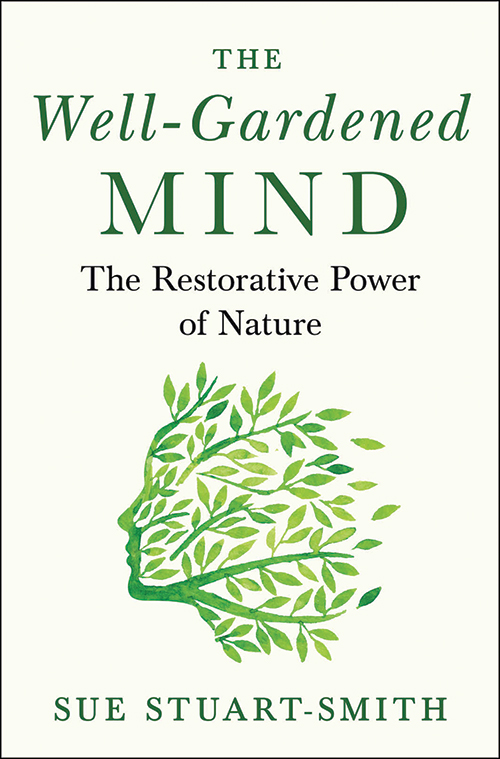
The Well-Gardened Mind: The Restorative Power of Nature
Reviewed by Pamela Haines
January 3, 2021
By Sue Stuart-Smith. Scribner, 2020. 352 pages. $28/hardcover; $14.99/eBook.
I stepped into this book ready to be supported in my love of gardening but curious about how much more could be said on the topic. It seems so simple and obvious: there’s something rooted and regenerative in cultivating beauty and doing one’s part in the provision of sustenance. I was reassured by the opening chapter that I was in good hands, but where would we be going?
I kept being surprised. Sue Stuart-Smith is medically trained as a psychiatrist, so her attention never strays far from health. But with physical, mental, emotional, spiritual, and community health, the vistas are broad. So reading this book was like going on a tour where the terrain was generally familiar, but attention was called to details I had never seen, or to ways of looking that brought the familiar into a new focus. We would be considering a lovely flower, for example, and move straight into the intricacies of how the inner workings of the brain allow us to recognize beauty, and the impact of such recognition on our nervous system. Or as we visited a restful hospital garden, we would find ourselves diving into a study of how the view through a hospital window impacts recovery from surgery.
We traveled widely—to gardens focused on physical and mental healing throughout Britain, to community gardens in New York City and prison gardens in California, to gardens of the descendants of early hunter-gatherers in Papua New Guinea, to the trenches of World War I and the Turkish prison camp where Stuart-Smith’s grandfather almost died, to the Alpine meadows and Austrian villas where Sigmund Freud found sustenance in nature—always circling back to her garden home in Britain, lovingly created from barren beginnings and nurtured over decades to become a source of endless learning and delight.
Through these travels, the healing power of interacting with green and growing things settles deeply into the heart: for those Indigenous women who gardened as their ancestors did, for people traumatized by assaults on their bodies and minds, and for those trapped in worlds of metal and concrete. I was particularly struck by the story of working people in the early industrial towns of England, who had lost not only their connection to the land but their traditional crafts. Many of them cultivated flowers in bits of space and sunshine, in a vibrant and extensive network of clubs and breeding competitions. Though access to agency and beauty had been almost entirely cut off by forces beyond their control, they found a way of claiming both in these small pots of auriculas.
We are introduced along the way to many great garden lovers, including Wendell Berry, who suggests that affection for the land is the key; Florence Nightingale, who reminds us that fresh air and daylight are the forgotten antibiotics; Sigmund Freud, with his passion for flowers and natural beauty; Voltaire, whose advice “Il faut cultiver notre jardin” (We must cultivate our garden.) speaks directly to our times.
Stuart-Smith decries the materialism of our time and the desacralization of the natural world. She finds many ways to speak of nature’s healing and centering powers: seeds with tomorrow ready-built into them, trees that do not flinch from our pain, gardening as an assertion of peace in times of war, nature as a place to be alone but not isolated. I resonated with her assertions that the closer we look the more we see, and that gardening bridges the gap between doing and being. I was taken by her suggestion that being in a natural setting, from hunter-gatherer times to the present, encourages a state of relaxed and immersive attention, an attention that does not fatigue but restores.
This book is both a lovely tribute to gardeners throughout space and time; a scientific treatise on the healing powers of nature; and a call to shift from dominion to connection and restoration, to link our human health with the health of the planet. It would be a valuable addition to the bookshelves of gardeners, healers, lovers of nature, and those whose spirituality has roots in our identity as creatures of the earth.
Pamela Haines is a member of Central Philadelphia (Pa.) Meeting. Her most recent book is Money and Soul, an expansion of a Pendle Hill pamphlet by the same name.


